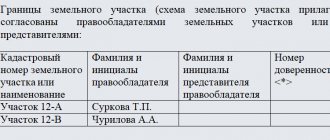Definition of concepts
After acquiring a land plot, citizens are responsible for preparing documents.
The first of these are the legal ones. They are considered not only one of the main ones. On the basis of such documentation, other documents are issued, including documents certifying the right. The latter is necessary as confirmation of registration actions for a particular property.
Not everyone knows where to get papers. The issuance of title documents is carried out by government agencies. The certificate contains basic information about the property, as well as the owner of the land plot.
Among the characteristics of the property are:
- location of the land with its address, if any;
- last name, first name, patronymic of the owner, data from his identity card (passport);
- a description of the site so that it can subsequently be identified among others;
- form of ownership determined during the transaction.
All documents must be prepared in compliance with the requirements of the legislative norms that are studied for their preparation. It is also necessary to focus on the form of papers prescribed in regulations.
Currently, you need to study the Federal Law on State Registration of Ownership of Real Estate and Land. It also reflects a complete list of documents that must be available when transferring ownership of the site. Registration of both title and title documents is required.
Types of documentation
After surveying, the owner receives a cadastral passport and a survey file, where all the identifying characteristics of the land are recorded. The set of papers required to confirm property rights consists of title and title documents.
Be sure to read it! What documents are needed for a marriage contract?
Due to their different legal meanings, they cannot be considered interchangeable varieties:
- Title documents for the land plot. They contain officially established facts of the land law that has arisen, arising from the very beginning, from the date of receipt of rights to the property. The basis for considering an allotment to be the possession of a specific person will be the primary act or agreement.
- Copyright certifiers. These include certificates confirming the right indicating its form. They arise as a result of registration of an object by Rosreestrom. Their peculiarity lies in the secondary design principle. Such certificates can be obtained only after presentation of the initial documents establishing the right.
Title documents for the land plot
State registration of rights to a land plot is a mandatory procedure, since real estate, due to its high economic importance, is subject to accounting. Without title deeds, land will have no legal status.
The procedure for processing papers is regulated by the legislative act Federal Law No. 218 of July 13, 2015 “On state registration of real estate.”
According to the law, title documents for a land plot contain information about the property and its owner. These include:
- site location data;
- territory address;
- description of the characteristics of the site - area, boundaries of the territory;
- type of ownership.
The same Federal Law defines a list of acts that the owner of real estate must possess. These include:
- Wills and certificates of the right to inheritance or its share.
- Agreements and acts of purchase and sale, exchange, donation and other types of real estate transactions, as well as acts of prima transfer.
- Court decisions - decisions, agreements, sentences.
- Resolutions and orders of the local administration and the Bureau of Technical Inventory (BTI), establishing the ownership of the object by one person or another.
- Short-term and long-term rental or leasing agreements.
Reference . All other documents for real estate are issued on the basis of title deeds.
List of title documents
The main type of title document is an agreement concluded between two parties, be it a buyer and seller, or a borrower and a financial institution. Such documents do not exist in oral form.
Common types of title documents:
- purchase and sale. The alienation of the object occurs for a payment established by the seller;
- donation. The donor transfers the right to use the land free of charge. The object passes to the new owner immediately after the conclusion of the contract;
- exchange. Exchange of land for another type of property or product. Additional payment is provided;
- inheritance agreement. The owner transfers the right to use the site free of charge. The territory passes to the heir after the death of the owner;
- rent. Payment of rent payments occurs within the period established by the parties. Despite this, the tenant has the right to use the territory for agricultural or subsidiary activities.
There are other types of title documents. For example, a deed for a land plot (provided by the state), a mortgage agreement, property management, lifelong use of land, a court decision.
Title documents for the land plot
Title documents for a land plot are documents obtained on the basis of title documents. They record the fact of registration of a transaction with an object with government agencies.
The list of such documentation is quite wide and depends on the specific situation and purpose of provision. The main ones include:
- Certificate of ownership of the land plot. Identifies the property and its owner. It is issued by local authorities. The document is a standard form with a unique number. This number is used to identify the site and provide all basic information upon request.
- Certificate of lifelong inheritable ownership. Such a document is no longer issued; only certificates issued in the USSR remain in circulation.
- Certificate of right of unlimited (permanent) use. Currently, it is also not issued, since this type of right obliges the owners to register ownership of the property, including a land plot.
List of legal documents
In the legislative framework, there are four types of title documents. Let's look at each of them:
- Certificate of ownership of the territory. The main supporting document that completes any transaction involving the transfer of ownership. Without such a document, it is impossible to manipulate the land plot, since the certificate confirms that the land belongs to you.
- Certificate of the right to lifelong ownership of the plot as an heir. It is not a document that would confirm ownership. Despite this, it is important when making transactions. This is because the land with the right to lifelong use is registered with Rosreestr in the name of the owner.
- Certificate of the right to perpetual use of the territory. In other words, it is an annuity agreement, only concluded for an unlimited period. It may involve both payment of rent and be issued free of charge. Often the right is granted by the state.
- Act on the right of permanent ownership (indefinite use of land). The land transfer act is issued upon conclusion of a certificate of the right of perpetual use (issued by the state).
Types of land rights
There are certain types of rights that land owners may have:
| Easement | If it is registered, the right of ownership is limited. A citizen can use someone else’s land to travel or lay a highway. |
| Public easement | Determined by the authorities. It can be imposed by federal, regional and municipal authorities. An easement is required to comply with the interests of the state and individuals. Land plots are not confiscated in this case. |
| Private easement | It is imposed within the framework of current regulations of authorities at various levels. |
| Free urgent right | It is issued by the owner in favor of another person. The agreement contains a specific rental period that is agreed upon by both parties. It is important to register it so that the corresponding right to real estate is formalized. |
| The land can be used on a permanent basis | In this case, the owner provides the site within the framework of current federal, regional and municipal regulations. |
| Lifetime inheritable ownership | Such a document only makes it possible to transfer a plot of land by inheritance. |
| Ownership | If it is available, the citizen has the opportunity to dispose of the object at his own discretion. He carries out various registration activities with it. Sale, donation, and inheritance of the plot are permitted. |
The right of private property appears in two cases. In the first, it is a consequence of the acquisition of a piece of land. It is important to comply with legal requirements.
The second case of acquiring a right is compliance with the conditions of legal personality. This is provided if the land was donated or inherited.
Many citizens of the Russian Federation have an inaccurate understanding of the rights registered to a land plot. Some people believe that they can use the land as they wish.
This proposition is false. After all, use is possible only in compliance with the requirements of regulations at various levels.
Sample birth certificate
List of title documents for land
* It is a document of title only in cases where a gradual purchase of the site from the current owner is planned. The tenant pays both rent and redemption price (monthly) and ultimately becomes the new owner of the land.
This federal law regulates the procedure for registering ownership rights to plots (and other objects), and also provides requirements for the relevant documents. The text must be written legibly, words are used in full, without abbreviations. Agreements are drawn up in at least 2 copies - 1 for each party (in practice, they are drawn up in 3 copies, since another 1 agreement remains with the transaction registration authority - Rosreestr). Each of these copies is drawn up in its original form (not a copy) and has the same legal force.
Interesting: What Documents Must Be Submitted to Apply for Benefits for a Veteran of Military Service
List of title papers
There are several documents of title that give the right to use and own a plot of land.
These are:
- a certificate confirming the ownership of a plot of land by an organization or individual;
- a certificate giving the opportunity to use the land on a permanent basis throughout life as a result of inheritance;
- a certificate giving the right to use the land plot without a certain period of time;
- an act issued by government bodies, which makes it possible to obtain ownership, use the land by right of inheritance for life, use the site on the basis of Resolution of the Council of Ministers of the RSFSR No. 493 (dated September 17, 1991).
Agreements and other types of transactions
Property can be acquired in various ways. Therefore, documents included in an extensive list can certify the existence of the right to it.
Registration of objects is carried out on the basis of:
- an agreement providing for the purchase and sale of a plot of land;
- agreements on the transfer of a mortgage loan facility;
- deed of gift;
- wills;
- a document on the citizen’s acceptance of an inheritance, drawn up with the assistance of a notary;
- judicial decisions or regulations;
- privatization agreement.
However, this list is incomplete. Based on each of the documents, land, a summer house, or private home ownership can be registered.
Sometimes citizens require non-standard papers to register property rights.
Among them are:
- certificates confirming the use of property as collateral;
- extracts certifying that the real estate was exchanged;
- orders and resolutions of government bodies;
- certificates of winning a land plot.
There are many grounds for the emergence of property rights. However, obtaining them is not always possible. It is important to take into account various subtleties and nuances.
During construction
If you plan to develop a plot of land, you need to prepare documents in advance. A citizen will not be able to just start building a house on land, even if he purchased it under a sales contract.
The procedure will need to be approved by the BTI. If this is not done, the construction will be considered illegal. The erected property can be demolished by government agencies without obtaining permission.
During privatization
One of the grounds for acquiring ownership of a land plot is the privatization procedure. During this process, property owned by government agencies becomes private property. Every citizen of the Russian Federation has the right to privatize an object.
The basis for starting the procedure is a social tenancy agreement. It represents a legal certificate. After the operation, a privatization agreement is issued. Based on this, an extract from the unified state register or certificate is prepared.
To privatize land, you need to contact the city administration. It is also possible to visit a gardening community.
What documents are needed for a land plot: title and title documents
Supporting documents are attached to the main documents. For example, when owning a land plot through privatization, a confirming administrative act is required, and when buying a land plot, a redemption act with a paid receipt is required.
With regard to documentation prepared before 1997, there is a certain reservation: the legal effect is retained by papers that are consistent with the current legislative norms and provisions that were in force at the time of execution. Documents drawn up with the assistance of a notary, including those drawn up before the collapse of the Soviet Union, remain valid. However, before you re-register the plot to the new owner, you will have to go through the procedure of re-registering the documentation in accordance with the requirements for them at the moment.
What to do in case of loss
If there are no title papers for a plot of land, then their immediate restoration is required. For example, this can be encountered when documents are lost.
Some citizens ignore this legal requirement. In this case, sanctions may follow. The local administration may decide to file a claim in court. The body has the right to deprive a citizen of his property or take away a plot of land for disposal by the municipality.
If a citizen himself has seized a plot of land, he must register it officially. However, it is important to remember that such actions can lead to disastrous consequences. In this case, the citizen will need to pay a fine of varying sizes. The final amount is determined based on the owner's status.
After paying the fine, you need to prepare a full package of documents. Otherwise, the land will be seized and transferred to the owner by law or to a business organization.
To restore documents, you need to contact the administration of the locality where the object was registered. The archive usually stores all information about the land plot.
If the administration does not provide papers, you need to contact the judicial authorities. The application is drawn up and submitted along with other documents to the site. Witnesses may also be invited to testify.
An administrative decision has the same force as a judicial decision. Once ownership has been established, the citizen can legally use the site.
Title documents are mandatory. Therefore, they must be issued immediately or restored if lost.
The right to permanent, unlimited use of a land plot
The right to permanent, unlimited use of a land plot, according to the legislation regulating land relations that is current for 2020, is not available to all users of land resources. This use of land to this day has not lost its relevance only for individuals.
Using land on a permanent basis without having legal documents for it is a legacy of the legislative framework of the Soviet Union. In the past there was no concept of private property. All resources belonged to the state represented by local authorities or other forms of self-government. A citizen or legal entity was allocated a share on which it was possible to implement production programs or run a subsidiary farm. Entrusted plots could be used exclusively for personal purposes, and the right of ownership did not extend to them. Although, in fact, there was no need for that.
Before the adoption of the current Land Code, land was not a commodity. That is why it was impossible to carry out legal manipulations with it regarding making a profit, for example, to sell it. Today the situation has changed, therefore both ordinary people and civil servants representing institutions have the right to take actions with the land that do not contradict the law and, of course, do not harm the environment. This requires unconditional compliance with special conditions.
Features of permanent use of land
Lawyers consider the emergence of rights and obligations to be a feature of the permanent use of a land plot transferred to a citizen or organization.
A person who disposes of a land plot indefinitely has the right:
- Use the territory within the intended purpose of the land. The permitted use of the allotment is indicated in the document on perpetual use.
- Construct a residential or commercial building, subject to compliance with architectural standards and all technical construction conditions.
- Use subsoil, such as water or soil, but exclusively for personal needs. A person has no right to sell water or minerals.
Indefinite use of a land plot requires the fulfillment by a citizen of the following duties:
- Preservation of the resource in its original form. The owner must maintain the fertility of the land, prevent the drainage of rivers and other waterways on the site, preserve green spaces and provide landscaping to replace withered trees.
- Protection from pollution by chemical, biological and other waste.
- Fire prevention.
- Eliminating the causes and consequences of flooding.
- Keeping the area clean.
At the same time, a person who has the right to use a land plot indefinitely is not given the opportunity to carry out other operations on the alienation of entrusted property, to which lawyers include the conclusion of agreements relating to:
- leasing;
- inheritance;
- exchange;
- sales;
- donations.
Russian legislation stipulates that in order to carry out any legal actions, the user of a land plot must acquire ownership of the plot, as well as pay annual fees to the state for the right to own and dispose of the land.
Also, in order to streamline and reliably maintain land records, norms have been legislatively approved that require obtaining a cadastral document and establishing ownership rights to all plots in a short time.
Expiration date of the right to unlimited land use
The expiration date of the right to perpetual land use is limited at the legislative level. After the adoption of the Land Code, the deadline for use on an indefinite basis was set at the beginning of 2014. It was up to this moment that the owners of the plots had to declare to the land resource registration services their desire to re-register the plots that had once been issued for indefinite use.
After the allotted time, the people's representatives, by an amendment to the Law, postponed the deadline for filing applications for legal entities, and after that, land users were given a year to comply with state requirements.
Individuals, as well as some associations of citizens (garden communities and garage cooperatives), were not affected by the amendments, although in order to sell or transfer to other owners the land and objects built on it, citizens, on their own initiative, began to actively re-register documents.
After the procedure for demarcation and assessment of land plots, all applicants are issued a document with a cadastral number. This procedure means formalizing the complete transfer of property rights and alienation of the plot in favor of the applicant.
Responsibility for violation of re-registration deadlines
Liability for violating the deadlines for re-registration of land applies only to legal entities. In the event that land management authorities discover a failure to comply with the norms prescribed by the latest amendments to the Land Code, the enterprise or organization will have to pay a fine.
The limit on the amount that will have to be deposited into the treasury account is set at one hundred thousand Russian rubles. Individual entrepreneurs who violate the law can be punished in the amount of twenty thousand Russian rubles.
Another action on the part of the state for those who have not complied with the requirements of the state authorities in a timely manner is an increased taxation rate for the plot upon subsequent re-registration of the land plot, as required by law. Re-registration of rights after verification is a priority.
It is also important to note that the perpetual right to use land is currently reserved for non-profit organizations and state-owned enterprises.
In conclusion, the article should be said about the risks that occur in the case when the land was not re-registered to a citizen in a timely manner in accordance with the requirements of the law. From the day of the owner’s death, a plot that was in the perpetual ownership of a given citizen is subject to a special rule of termination of rights: the plot of land becomes ownerless, and all existing heirs of the person who previously disposed of it lose the right to receive the plot as an inheritance. Such territory passes to the state and can be put up for auction.
>What is the title document for a land plot and their list
Use of a Land Plot Without Title Documents
According to the Decree of the Government of the Russian Federation of June 30, 2006 N 404, the title documents for a land plot are: a copy of the act of the state authority or local government; cadastral plan of the land plot; other documents confirming the provision of a land plot to a given subject, or an extract from the Unified State Register of Rights to Real Estate and Transactions with It.
Interesting: How to calculate UTII tax by area
Unauthorized occupation of a land plot is an administrative offense, the objective side of which is expressed in the placement on the land plot of buildings, structures, fencing, taking other measures to prevent access to it by legal owners (owners, tenants, other users) or controlling persons, in particular security; or by sowing (planting) agricultural and other plants, etc.
Types of documents for memory
In addition to the cadastral passport and land survey file, which reflect the characteristics of the plot after land surveying, the landowner needs to provide himself with two types of documentation for the land plot.
We are talking about title and title documents. They create a civil precedent for property guarantees of a person. Legally, they have different powers and cannot be mutually replaced, reflecting the functional features of ownership of the memory.
Title documents for a land plot are officially issued information about the fact of the emergence of the right to a plot. They appear initially, at the moment of acquiring the right to own it. That is, ownership of the plot arose on the basis that is recorded in the primary act or agreement.
Title documents are certificates confirming ownership of a plot of land and stating the form of the right.
They were issued as a result of registering the memory with Rosreestr. They state the fact that information about him is available in the State Real Estate Cadastre (GKN). They are also secondary in order of receipt. Their issuance is permitted only upon presentation to the State Tax Committee office of primary proof of ownership, which is a title document.
List of title and title documents for a land plot
After completing a transaction or other type of transfer of ownership in Rosreestr, the owner is issued a certificate filled out in a form approved in the region. The basis for its issuance is the application of the owner who provided the title documents.
Applications accepted by the MFC are sent to Rosreestr in an interdepartmental data exchange procedure. The result of submitting an application in all cases will be the entry of information about property rights into the state register of the Unified State Register of Real Estate and the issuance of a corresponding certificate of title to the copyright holder.
Title documents for the land plot
The type of document that acts as a title document depends on the legal precedent as a result of which the owner came into possession of the land plot. These include, among other things, acts on the issuance of allotments received back in the last century, within the framework of Soviet Land legislation.
Their relevance has not been lost to this day. They cannot be replaced by certificates and other documents issued later. The legal capacity of this type of securities is determined by the Federal Law of October 25, 2001, on the entry into force of the Land Code of the Russian Federation, No. 137-FZ.
If the plot was acquired within the framework of Russian legislation, the agreement and other information about its acquisition, drawn up as an official document, refer to legal precedents.
So, the documents certifying the rights to a land plot are:
- Administrative acts on the allocation of land, extracts from administrative acts or resolutions of the board of collective farms (state farms) on the provision of land.
- Property transaction agreements: deed of gift, deed of sale or exchange agreement. If the plot was acquired as a result of a civil action.
- Certificate of inheritance - for lands received by will or as a result of the transfer of property rights from a deceased owner.
- Lease agreements – for renters.
- An extract from the court decision if ownership was disputed in court.
If the plot was involved in privatization, an administrative state act on the transfer of rights is attached to the main document. If it was purchased from the administration, in addition to the redemption certificate, a receipt for payment of the cost of the loan is attached.
Only title documentation allows real estate to participate in a property transaction or transfer by inheritance. On its basis, it is possible to determine the characteristics that are significant for the title of land plot, reflecting the purity of the transaction and the peremptory legal capacity of the allotment.
Now you know what is the title document for a land plot, but there is another very important type of document for land plot, more on that below.
Legal documentation
This type of document contains expanded information about the land plot and certifies:
- The form of legal capacity on the basis of which the subject owns the plot.
- Information about the owner and basic cadastral characteristics of the site.
- Location (address) of the land plot, cadastral number.
It is provided to citizens after a property transaction or another option for registering ownership, in the form of a certificate issued by Rosreestr. Filled out according to the form established in the region at the location of the storage facility. Issued at the request of the copyright holder upon presentation of a title document. Information about it is entered into the certificate.
The types of documents are determined by the method of ownership. The main certificates and acts are:
- state act on the land plot on ownership;
- certificate of acceptance and transfer of land plot;
- lifelong inheritable ownership;
- permanent (perpetual) use of memory;
- certificate of tenancy.
Based on one of the listed documents, the owner can carry out legal transactions that require confirmation of his legal capacity to dispose of the site.
For example, register an encumbrance, divide the land, transfer the land for rent, purchase and sale or donation. And also - use the memory for its intended purpose, benefiting from it. Business activity is allowed on such a site. But for citizens who own land indefinitely, registration of a legal entity is not allowed.
Attention, if the allotment is used for other purposes, it is possible to confiscate the storage for state and municipal needs.
The designated certificates are involved in property transactions, along with title-establishing types of papers, if the designated type of right is regulated by law for the transaction.
Certificates are issued in accordance with the Federal Law “On State Registration of Rights to Real Estate and Transactions with It,” dated July 21, 1997, No. 122-FZ.
We have provided a list of documents for the land plot, now let’s talk about their legal force.
If you need to receive an extract from the Unified State Register in a short time, take advantage of the special offer from our partners below.
Title and title documents for the property
The right to ownership of a house, land, apartment or other real estate is approved by various papers. However, they alone will not be enough to take possession of a certain property. It is also necessary to provide documents that confirm the legality of the title papers. These are legal or legal documents.
Be sure to read it! Refund Letter: Sample 2020
Since 1998, operations relating to real estate have been handled by Rosreestr, which registers such transactions in the Unified State Register. Before this, such agreements were registered with the BTI, and since 2020, an extract from the Unified State Register is the only confirmation of the existing right to own real estate.
A title document is an act filled out on a state form, having all degrees of protection, which confirms ownership, if there is a record of this in the Unified State Register. There are several types of such papers for an apartment, depending on when the transaction was made:
- registration certificate from the BTI - provided upon confirmation of ownership of the apartment until January 31, 1998;
- a certificate of home ownership, which was issued in the 1990s;
- certificate of state registration of rights - valid since February 1, 1998 and confirms the rights to own any real estate.
On house:
- certificate of registration of ownership of a private house;
- a certificate issued by the selection committee on the commissioning of this object - if the house was built by the person who is selling it.
Title documents for land:
- certificate of ownership (lease agreement or transfer of agricultural land for temporary use);
- certificate of the right to permanent (that is, indefinite) use of the site;
- certificate of the right of inherited lifelong ownership;
- state act on the right of ownership, lifelong inheritable possession or permanent use.
Loss of papers
If papers are lost, urgent restoration will be required. Otherwise, if their absence is detected, the administration of the locality has the right to make a decision on the squatting of the land plots on the basis of Article 7.1 of the Code of Administrative Offenses of the Russian Federation.
If you have arbitrarily seized a plot of land, then you need to register it as your property. This procedure is described in more detail in our other article.
Such actions may have consequences in the form of penalties in the amount of:
- 500 – 1000 rubles for individuals;
- 1000 – 2000 rubles for officials;
- 10 – 20 thousand, for entrepreneurs.
If after paying the fine the documentation is not prepared, then on the basis of Art. 76 of the Land Code of the Russian Federation, the lands will be confiscated for transfer to the legal owner - an economic entity.
If a loss is discovered, you should immediately report the incident to the local executive committee for their restoration. The source of the right should be sought in archival information. If information about the free provision of memory is not found in the archive or administrative records, you need to file a claim in court.
The statement of claim requests the restoration of rights to ownership of the site. The application is accompanied by those papers that are available to the landowner. Their deficiency can be compensated for by testimony that the site is used by the plaintiff.
An administrative decision to recognize ownership of a land plot is equivalent to a judicial decision. Based on the recognition of the right of ownership by these authorities, it is possible to restore the legal capacity of the allotment, with mandatory registration in Rosreestr.
The necessary documents for a land plot determine its legal status and legal capacity. If they are lost, they must be restored through judicial or administrative procedure.
Title documents for a house are the basis for registering property rights in Rosreestr. These are primary documents that establish the fact of ownership. Let's take a closer look at the primary and secondary title documents for a house (cottage) - an individual housing construction project.
Article updated 07/06/2018
Title documents for the house
Before establishing ownership of a house, and then registering it in Rosreestr with making an entry about this in the Unified State Register of Real Estate, you first need to attest to its existence, describe its technical characteristics and “link” it to the land plot.
The state registration body, Rosreestr, keeps records of all real estate in the Russian Federation.
Both the real estate objects themselves are subject to registration - cadastral registration - and the rights to them - making an entry in the register of rights.
Title documents for a residential building
A newly built house (cottage) must be registered in the cadastral register, only then is it possible to register ownership of it.
Cadastral registration of a residential building is carried out on the basis of a Technical Plan, which is prepared by a cadastral engineer - a certified specialist.
A cadastral engineer must have a state certificate and be a member of a self-regulatory organization of cadastral engineers.
A cadastral engineer is a specialist who performs work in the field of land surveying, cadastral work related to real estate, and can also engage in land management examination.
The register (list) of cadastral engineers is posted on the official website of Rosreestr.
The cost of cadastral work for an individual residential building varies greatly by region and can range from 5,000.0 rubles to 50,000.0 rubles or more.
Based on the Technical Plan and the application of the cadastral engineer to Rosreestr, the cadastral registration of the newly built house will be carried out and this data will be entered into the Unified State Register of Real Estate.
Receive a Cadastral passport for your home from Rosreestr as confirmation of the cadastral registration.
A cadastral passport is an extract from the state real estate register containing information about the property: cadastral number, address, technical characteristics and cadastral value.
Title documents for a new home
- Cadastral passport
- Commissioning certificate (may not be provided until 03/01/2018)
- A document for a land plot confirming your right of ownership or use - Certificate of ownership (or extract from the Unified State Register of Real Estate) or Land Lease Agreement
Based on the above documents and the application for registration of property rights, a record of the right will be made in the Unified State Register of Real Estate.
The state fee for registering property rights is 2000.00 (for 2020) and is paid to the budget.
Documents for registration of rights can be submitted through the MFC or directly to the office for receiving and issuing documents of Rosreestr, if there is one in your locality.
Cadastral registration and registration of rights can be carried out simultaneously.
Art. 70 Federal Law-218 “On state registration of real estate”:
7. Until March 1, 2020, the grounds for state cadastral registration and (or) state registration of rights to an individual housing construction project created or created on a land plot intended for individual housing construction, or to an individual housing construction project created or created on land plot located within the boundaries of a populated area and intended for running a personal subsidiary plot (on a personal plot of land), there are only a technical plan of the specified individual housing construction projects and a title document for the land plot, if the applicant’s right to the land plot is not registered in the Unified State Register of Real Estate , on which the specified individual housing construction objects are located. In this case, information about an individual housing construction project, with the exception of information about the location of such a property on a land plot, is indicated in the technical plan on the basis of the cadastral work submitted by the customer for a construction permit and design documentation for such real estate (if any) or a declaration about the facility real estate provided for in Part 11 of Article 24 of this Federal Law (in the event that project documentation was not prepared).
Title documents for the house (secondary object)
If there is a transfer of ownership from the owner (copyright holder) to another individual or legal entity, a contract or agreement regarding this is drawn up. This document will be the title document for registering rights to the new owner.
The title documents for re-registration of property rights (transferring rights from the former owner to the new owner) are:
- purchase and sale agreement and transfer and acceptance certificate
- gift agreement
- certificate of inheritance
- agreement on division of jointly acquired property
- agreement on the allocation of a share in property rights
Related topics:
- Rights to a land plot What documents confirm ownership of land? Any real right that has arisen, including ownership of land, is subject to...
- Find out who owns the site Methods of collecting information Rosreestr Federal Law of July 21, 1997 No. 122-F3 and Art.…
- Documents for the car list What documents are needed for the car Mandatory documents include the vehicle passport (PTS) and…
Registration of ownership: documentation for the land plot
Another important aspect is the fact that the certificate of state registration of property rights is only valid along with other title materials. This certificate must contain a reference to the document that establishes the proprietary rights to the specified real estate (resolution of acceptance/transfer, deed of sale, decision on division, decision of the founder, minutes of the meeting). It is also necessary to indicate the subject/object/type of right, conditional (cadastral) number, all existing restrictions on proprietary rights (if any).
We recommend reading: Realtor Agreement







